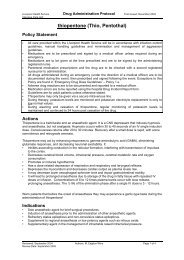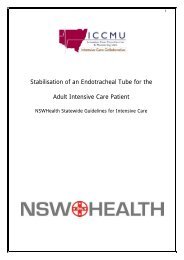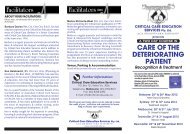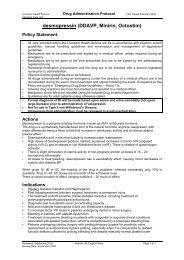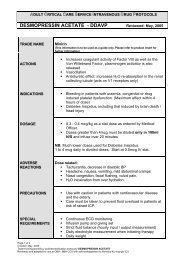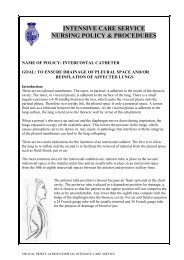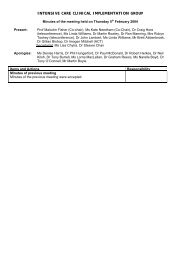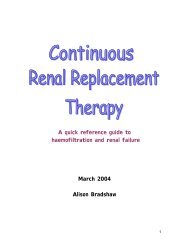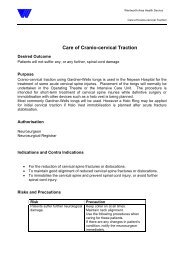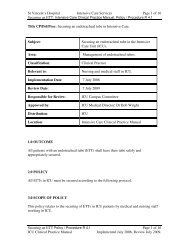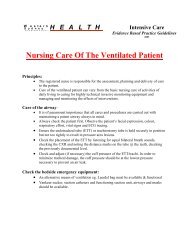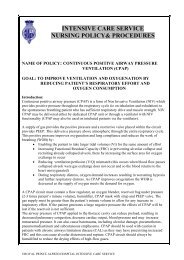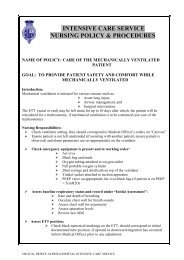CRITICAL CARE
CRITICAL CARE
CRITICAL CARE
Create successful ePaper yourself
Turn your PDF publications into a flip-book with our unique Google optimized e-Paper software.
Central Sydney Health Service Royal Prince Alfred Hospital<br />
� Set respiratory rate to maintain the minute ventilation (MV) that was recorded prior to<br />
changing the ventilator settings (set f = old MV divided by new VT in litres). This may not<br />
be possible as the maximum set respiratory rate (f) is 35<br />
� Ensure that Autoflow is turned on.<br />
� The airway pressure alarm must be set at 35 cm H2O.<br />
This will limit the maximal airway pressure to 30 cm H2O.<br />
� Turn the Flow Trigger “On” and set it to 2 L/min<br />
� Adjust the Inspiratory time to start with an I:E ratio of 1:3. I:E ratio is displayed in the<br />
bottom left corner of the “Ventilator settings” screen when Tinsp is selected.<br />
� Adjust the FiO2 and PEEP as outlined in the section arterial oxygenation goal<br />
(see below).<br />
SUBSEQUENT VENTILATOR ADJUSTMENTS<br />
TIDAL VOLUME AND INSPIRATORY TIME ADJUSTMENTS<br />
� These may be necessary if the alarm “pressure limited, volume not constant” occurs.<br />
This alarm indicates that the ventilator cannot deliver the programmed volume in the time<br />
allowed whilst keeping the pressure under the alarm limit of 35 cm H2O (actual airway<br />
pressure of 30 cm H2O). In this case the ventilator will deliver a lower tidal volume,<br />
rather than exceed the pressure limit. There are two solutions to this problem.<br />
1) Increasing the inspiratory time allows more time for the set tidal volume to be<br />
delivered without exceeding the pressure limit. Initially, the Tinsp should change I:E<br />
ratio from 1:3 to 1:2. If this does not help an I:E ratio of 1:1 should be used.<br />
2) If the above does not resolve the alarm reduce the tidal volume in one ml/kg IBW<br />
increments. This may be repeated every few minutes to a minimal tidal volume of<br />
4 ml/kg IBW. The tidal volume should not be reduced below this. If a tidal volume<br />
of 4 ml/kg is necessary, medical staff should be made aware.<br />
� If the patient’s tidal volume is less than 6 ml/kg IBW, regular attempts should be made to<br />
increase it, in 1 ml/kg IBW increments, back towards 6 ml/kg. The ability to do this will<br />
be limited by the alarm “pressure limited, volume not constant” as described above. A<br />
tidal volume of 8 ml/kg may be used after discussion with the ICU consultant and<br />
documentation in the notes.<br />
� If the patient is receiving 6 ml/kg IBW, attempts should be made to reduce the inspiratory<br />
time to give an I:E ratio of 1:3.




